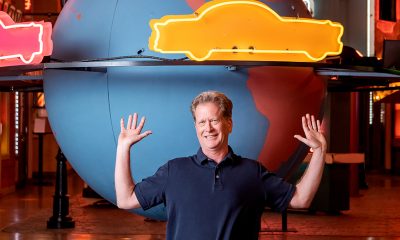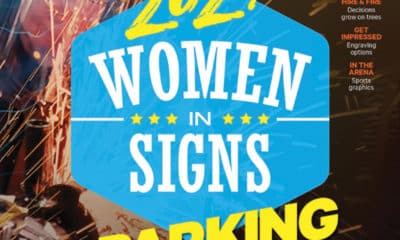Design
Prints with Drive
A gallery of Ferrari Color applications
Published
13 years agoon

Creative Color was founded in 1978 in Salt Lake City as a photographic-imaging provider. The current leadership team assumed control of the company in 1987, and the company gradually entered the wide- and grand-format imaging markets as printing technology and media capabilities improved.
In 2001, the company purchased Sacramento-based Ferrari Color, and subsequently assumed the acquired company’s name two years later. Today, the shop maintains three facilities – in Salt Lake City, Sacramento and Emeryville, CA – and operates a host of production equipment, which includes:
• A Canon ImagePress, which is used to laser-print decals and tabletop signs on various paperstock types;
• Five Dursts: a Lambda RGB, single-beam laser printer; a Rho 160R roll-to-roll, UV-cure printer; a 351R, roll-to-roll UV printer that prints on coated or uncoated media up to 139 in. wide; a Rho 800 UV-cure-ink, flatbed machine, which prints at 600 dpi on substrates up to 1.58 in. thick; and a Pictor, a flatbed, UV-cure-ink printer with white-ink capabilities.
• An HP Scitex XL 1500 eight-color, 16-ft.-wide printer that decorates banners and mesh material;
• A Roland DGA SJ-740 dye-sublimation fabric printer with 1,400 x 1,400-dpi resolution;
• A Summa S160 vinyl-cutting plotter;
• And, a 10-ft.-wide Mimaki JV5-320S dye-sublimation printer for behemoth, fabric-printing applications.
Ferrari’s portfolio includes numerous projects that have earned awards in ST competitions, such as its 175 x 65-ft. building wrap for Maloof Sports & Entertainment that promoted the Sacramento Kings, which Maloof owns, on that city’s CalSTRS building (see ST, April 2011, page 74), and its inspiring banner installation for the U.S. Ski & Snowboarding Assn.’s Park City, UT headquarters (see ST, April 2010, page 86).
However, vinyl applications comprise numerous shapes and sizes. Just because a client isn’t bankrolling a gargantuan vinyl wrap that will cover dozens of floors on a high-rise doesn’t mean it doesn’t deserve exacting attention to detail. Ferrari Color provided information about various applications that emphasize the materials and methods that help vinyl provide branding that resonates
Royal-worthy
Perhaps you heard about the April 29 wedding that betrothed England’s Prince William to Kate Middleton, which seemingly received more press coverage than a Presidential inauguration (it was the first royal wedding in approximately 30 years, and the goings-on of Kate’s sister, Pippa, provided an even more entertaining sideshow than President Carter’s wayward brother, Billy).
To help cable network TLC (formerly The Learning Channel) promote itself at the gala event, the network’s PR and marketing firm enlisted Ferrari Color to produce a series of stage skirts, promotional banners and backdrop graphics for a special edition of its wedding-dress-centered reality show, Say Yes to the Dress, to support its weeklong wedding coverage from on location in London. Ferrari began its work by executing all prepress refinement of the client’s original files using Adobe®’s Creative Suite 3.
To create the soft-sided signage, the shop used 13-oz. banner material (Ferrari’s choice for such jobs), which it decorated on its Durst Rho 351R, the company’s designated printer for its banners produced with UV-cure inks, on a four-color setting. To create hard-backed graphics, Ferrari decorated 3M’s 54-in.-wide IJ3650-114 clear media on the Rho 160 printer, which the shop allocates for adhesive-vinyl printing.
Phil Newman, Ferrari Color’s account manager for the job, said positioning the graphics around the backdrop, which served as the staging area for TLC’s reports of the wedding’s proceedings, proved challenging because of the exact positioning of the viewing screen to make sure it surrounded, but didn’t cover, it.
The Sweet Spot
In 1869, German immigrant Gustav Goelitz founded the Goelitz Candy Co. in Bellevile, IL, and the company thrived for nearly a century by producing jelly beans, candy corn and other sweets. However, the company reached iconic status when its “Jelly Belly” jelly beans, which were made with natural flavors to produce such varieties as root beer and cream soda, were made famous by Ronald Reagan during his stint as California governor (they remained a sweet staple during his presidency). The company subsequently changed its name to Jelly Belly, and ultimately relocated to Fairfield, CA.
Today, the company, regarded as the world’s premier jelly-bean producer, has entrusted Ferrari Color with producing various promotional graphics. In-store graphics strategically create a fun, whimsical environment that invites the all-important impulse buy. Prior to decorating the walls of the visitors’ center at Jelly Belly’s headquarters, installers painted them with semi-gloss paint, washed them with an alcohol and water mixture, and allowed them to dry for five days.
AdvertisementFerrari Color created the graphics using 3M’s Controltac media, which it decorated on its Durst Rho 160 printer. The store graphics entailed a 70 x 3.5 ft. ceiling graphic and four wall prints that span 104 ft. x 27 ft. 2 in. The company also decorated the smoking lounge at the company’s headquarters with five panels – four 3 x 7 ft. and one 3 ft. 8 in. x 6 ft. – printed on the Rho with 3M material.
Arden(t) Branding
Ferrari Color’s Sacramento facility produced a pair of projects for that city’s Macerich Arden Fair Mall. To help identify the facility’s family play area, Ferrari produced two sponsored column wraps for The Glass Agency, a Sacramento ad firm. After having painted, washed and dried the columns, the shop fabricated the 51 x 85-in. wraps using FLEXcon’s BUSmark® 5800 white, opaque, removable vinyl on the Durst Rho 160.
Ferrari also decorated the mall’s exterior doors and windows with a graphic that promoted a Susan G. Komen Foundation event and its ongoing mission to fight breast cancer. Because the installation called for a solid-color graphic, Ferrari eschewed inkjet printing and cut the job with Avery
deep-magenta and cotton-candy-colored vinyl on its Summa
S160 plotter.
Banking with Style
Ferrari Color worked directly for Tri Counties Bank, a wholly owned subsidiary of TriCo Bancshares with 61 Northern and Central California branches. The job entailed creating 14 ft. 9 in. x 9 ft. 6.5-in. graphics that decorate the glass walls of a conference room at the Marysville branch and a wall wrap for the South Chico location. Ferrari designed the wraps to be somewhat transparent, while depicting blossoming flowers, and specified 3M’s Scotchcal 3650-114 clear media for the projects.
To prep the walls for the application, installers washed the windows with trisodium phosphate and water.
Ferrari Color produced the panels – two wall-wrap panels that measure 9 ft. by 1 ft. 1.5 in., one 9.5 x 22.75 ft., and a 14 ft. 9 in. x 9 ft. 6.5-in. wrap for the conference room – on its Durst Rho 160 in the four-color setting. To facilitate installation, fabricators applied 3M’s SCPM-3 premask to the prints’ surface. To be rendered effectively on glass, Ferrari reverse printed the graphics on the material, and set each print to bleed to allow a seamless fit when producing the Adobe Illustrator®-generated design.
Arranging the prints to flow continuously across the conference-room enclosure’s six vertical panels required meticulously tiling the images, both with the software and its Caldera GrandRIP+ RIP.
Advertisement

SPONSORED VIDEO
Introducing the Sign Industry Podcast
The Sign Industry Podcast is a platform for every sign person out there — from the old-timers who bent neon and hand-lettered boats to those venturing into new technologies — we want to get their stories out for everyone to hear. Come join us and listen to stories, learn tricks or techniques, and get insights of what’s to come. We are the world’s second oldest profession. The folks who started the world’s oldest profession needed a sign.
You may like
Advertisement
Subscribe

Magazine
Get the most important news
and business ideas from Signsofthetimes Magazine.
Advertisement
Most Popular
-

 Projects1 week ago
Projects1 week ago4 of the Most Fun Sign Projects in Years
-

 News1 week ago
News1 week ago2024 Sign Contest Open for Submission
-

 How To1 week ago
How To1 week agoMaking the Grade with ADA Signs
-

 Real Deal2 days ago
Real Deal2 days agoA Family Sign Company Foists Their Youngest Upon the Business
-

 Editor's Note3 days ago
Editor's Note3 days agoThe Joy of Working
-

 News2 days ago
News2 days agoWoman Found Living Inside Supermarket Sign
-

 Product Buying + Technology4 days ago
Product Buying + Technology4 days agoEco-Solvent Printers: Workhorses of a Signshop’s Stable
-

 News1 week ago
News1 week agoSign Company Owner Meets Travis Kelce







